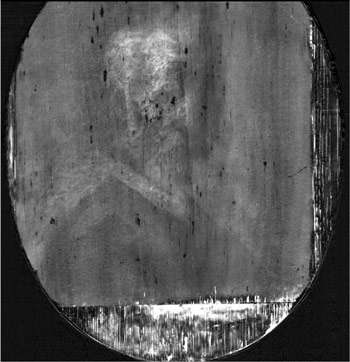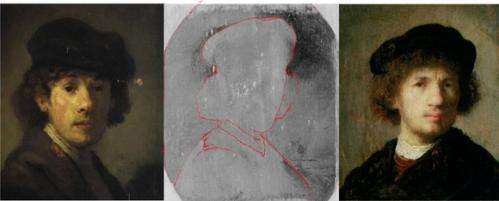(PhysOrg.com) -- Advanced imaging technology from the Brookhaven Labs and the European Synchrotron Radiation Facility (ESRF) in Grenoble has revealed an authentic Rembrandt self-portrait in an art authenticity effort involving leading art historians and scientists at the two labs. The hunt for authenticity all began when a private collector showed art historians in Amsterdam a small panel “Old Man with a Beard” from about 1630. The collector wanted to know if it was a Rembrandt.
The experts turned to the modern science of x-ray imaging for answers. The scientific work showed an unfinished self-portrait by Rembrandt under the paint surface.
The ESRF and Brookhaven sites performed the scientific explorations. Ernst van de Wetering, emeritus professor of art history at the University of Amsterdam and head of the Rembrandt Research Project, said the evidence was clear that this is a Rembrandt.
KES imaging of the painting Old Man with a Beard at beamline ID17 allowed a quick visualisation of the distribution of heavy elements in the paintings. Based on these results, the presence of a complete second figure could be excluded. Image credit: Koen Janssens.
The scanning technology that was used at ESRF was a dual energy X-ray imaging technique. The Brookhaven National Lab used used Macro-scanning X-Ray Fluorescence spectrometry (MA-XRF). Central to Brookhaven’s contribution was its new fluorescence microprobe system that can scan surfaces with high definition. The XRF technique was used with this new “Maia” detector system.
The detector can produce high definition maps of the spatial distribution of different chemical elements in a painting. The painting is placed on a motorized scanning stage that allows for element-specific mapping. A pencil beam of synchrotron radiation (SR) is swept over the painting.
Copper distribution map from XRF analysis with the contours superimposed on the hidden portrait (centre) (reconstruction by E. Van de Wetering). Comparison of the outline to other self portraits by Rembrandt van Rijn: Rembrandt as a young man (left), (© Metropolitan Museum of Art, NY, USA); Self portrait of Rembrandt (right), dated 1630, (© National museum, Stockholm).
The Maia detector, according to the publication Lab Manager, which details the technology used in the Rembrandt probe, is based on a massively parallel detector array composed of 384 individual detectors, an “on-the-fly” scanning system, and advanced analysis software. The publication reported that the detector was able to image the entire painting in about eight hours, in a task that would normally take about 30 days.
In general, X-ray Fluorescence (XRF) is considered a key technology for those in the art world, as it highlights pigments concealed beneath the surface, and has previously been used to authenticate works by Van Gogh and Goya, among other famous artists. The tool is especially helpful as it can determine chemical composition in a nondestructive way; the work of art is left intact.
Prof Ernst van de Wetering, an art historian at the Rembrandt House in Amsterdam, and head of the Rembrandt Research Project, had worked meanwhile with his team to examine the sketch for authenticity. The imaging results gave scientific support to authentication, which Prof. van de Wetering announced at the Rembrandt House Museum in Amsterdam on Friday.
From 1 May to 1 July 2012 the Rembrandt House Museum is staging a special exhibition of research into ten paintings by Rembrandt and his contemporaries using XRF technology.
More information:
www.labmanager.com/?articles.v … rs-of-a-Purported-Re
www.bnl.gov/bnlweb/pubaf/pr/PR … =1359&template=Today
webh01.ua.ac.be/mitac4/rembran … /oldman_pxrf_100.jpg
webh01.ua.ac.be/mitac4/rembrandt/index_301111.html
© 2011 PhysOrg.com
























